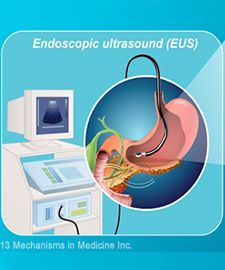
Metal stents placement EUS- diagnostic and therapeutic
Endoscopic ultrasound (EUS) is a minimally invasive procedure to assess diseases of the digestive (gastrointestinal) tract and other nearby organs and tissues. The high-frequency sound waves produce detailed images of the digestive tract and surrounding organs and tissues, including the lungs, pancreas, gall bladder, liver and lymph nodes.
An endoscopic tube may also have a small needle to remove fluid or tissue samples (biopsy) for examination in a lab
Why and when is it done
EUS and EUS-guided procedures can be used for the following:
- Assess damage to tissues due to inflammation or disease
- Determine whether cancer is present or has spread to lymph nodes
- Determine whether cancer is present or has spread to lymph nodes
- Determine how advanced cancer is
- Provide more-detailed information about lesions identified with other imaging technologies
- Extract fluid or tissue for diagnostic testing
- Drain fluids from cysts
- Deliver therapies to a targeted region, such as a malignant tumor
Risks associated with EUS
These risks, which are most commonly associated with fine-needle aspiration, may include:
